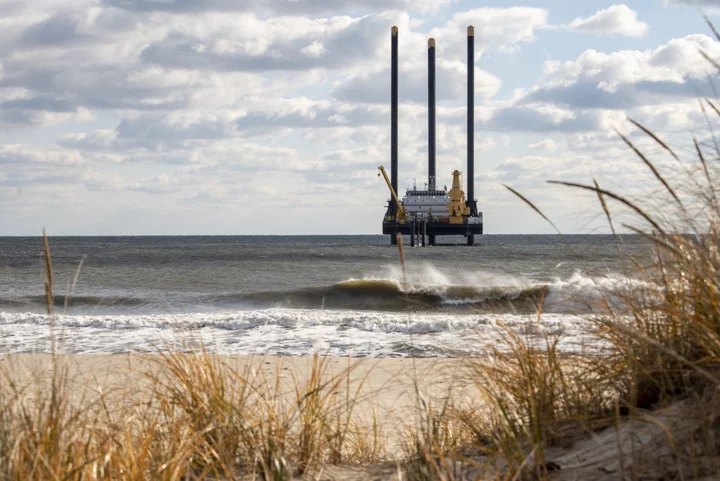The US offshore wind industry, banking on a big boost from the landmark Inflation Reduction Act, has found itself face-to-face with a major hurdle that’s been right there in the name all along: inflation.
In fact, the law might even be making it worse.
More than 10 gigawatts of offshore wind projects along the US East Coast — the equivalent of roughly 10 nuclear power reactors — are at serious risk as higher costs force developers to re-crunch the numbers for proposals originally modeled years ago, before a runup in interest rates and material costs. Orsted A/S, the Danish wind giant, said this week it’s prepared to walk away from projects unless it gets even more government aid. Other developers are already paying tens of millions in penalties to exit contracts they say no longer make financial sense.
“It’s pretty evident that inflationary pressures have blunted the impact” of the IRA, said Josh Price, a director with Capstone, a Washington-based research group. “It wasn’t a silver bullet.”
Read More: Orsted Ready to Abandon US Wind Projects as It Asks for Help
Orsted’s warnings are the most concrete example yet of the limits of the IRA, which was hailed as a key driver for America’s nascent offshore wind industry. While the law provides at least $370 billion in grants, tax credits and other incentives for climate and clean energy projects, that’s proving no match for rising inflation and borrowing costs. And by dangling higher incentives for companies sourcing US-made parts, it’s fueling demand before the domestic supply chain catches up, driving prices higher still.
“The irony here is that the Inflation Reduction Act probably has had some part in stoking inflation for some of the green goods that it intends to encourage,” said Kevin Book, managing director at ClearView Energy Partners LLC. The IRA is already spurring construction of new US factories to manufacture critical clean-energy gear, but that’s lagging behind renewable project development, exacerbating the issue in the short term. “It takes a long time to stand up a factory. It takes a long time to replace a foreign-sourced supply chain.”
Offshore wind developers are confronting rising costs for everything from financing for the multi-billion-dollar projects to the towers, turbines and foundations needed to support them. Just two years ago, they were making plans — and inking power purchase agreements — based on a projected cost of $77 per megawatt hour, according to BloombergNEF. Now, it’s $114.
John Podesta, a top Biden climate adviser, stressed these are the expected challenges of building out an all-new industry.
“We think that the economics will work out but obviously the first projects are the most challenging, because anytime you’re trying to build a new industry, you have to build” a supply chain, he said at a Climate Power roundtable in Washington on Thursday, noting that he’d just spoken with Orsted’s North American chief. “We’re still very optimistic that with the support of the Inflation Reduction Act, offshore wind has a very strong future.”
Orsted last week announced a potential $2.3 billion charge on its US portfolio, citing higher costs and supplier delays. Chief Executive Officer Mads Nipper has said he’s pressing the White House for more support — and otherwise might consider walking away. The company began offshore construction in June for the 132-megawatt South Fork project near Long Island, New York, and is planning several other ocean wind farms with almost 5 gigawatts of capacity.
Other companies are already pulling the plug on some deals. Shell Plc and its joint-venture partners agreed last week to pay more than $60 million in penalties to exit a contract for their 800-megawatt SouthCoast Wind project near Massachusetts. Avangrid Inc. in July agreed to pay $49 million to cancel a contract for its 1.2 gigawatt Commonwealth project, also off the coast of Massachusetts. The developers had signed long-term power purchase agreements to supply electricity, but those deals were based on being able to line up financing and suppliers at certain levels. They’re planning to participate in a new round of state auctions next year where they expect to seek new contracts with higher power prices. SSE Plc, which has talked for several years about potentially investing in the US, told Bloomberg it’s reconsidering.
Read More: Wind Farm Developer SSE Rethinks US Entry in Blow to Biden Plans
“Offshore wind is in trouble, in the US and globally,” Sy Oytan, Avangrid’s chief operating officer for offshore wind, said in July during a tour of the company’s Vineyard Wind project, south of Martha’s Vineyard.
Equinor ASA and BP Plc are facing similar hurdles for their Empire and Beacon projects near Long Island, New York, with 3.3 gigawatts of total capacity. In June, they told the state that “adverse economic impacts have imposed unprecedented and escalating cost increases on the projects.” To remain viable, Equinor and BP asked the state to approve a 54% price increase, according to documents filed last week. The company said it expects the state to issue a response in the fourth quarter and can’t say now what it would do if regulators reject their request.
Read More: Atlantic’s Biggest Offshore Wind Turbine to Rise in US
“Inflation and supply chain constraints have caused unprecedented disruption that developers could not have foreseen,” Lauren Shane, a spokeswoman for Equinor Renewables America, said by email Thursday. “While we have worked to manage these issues, given the unique moment in our global economy, this is an industry-wide issue that cannot be overcome at the project level.”
Offshore wind is uniquely vulnerable in the green-energy sector because it is at such an early stage in the US, springing up faster than port infrastructure, installation vessels and domestic supply chains that are still being built. President Joe Biden hopes to get 30 gigawatts of offshore wind generating capacity installed by the end of the decade — up from less than 50 megawatts today. But developers are operating without a blueprint, Capstone’s Price said.
“These are massive, massive projects that are very capex heavy,” he said. “It’s a much earlier stage for this industry and so necessarily it’s more risky, which makes access to capital harder, which is only exacerbated by the high interest-rate environment.”
--With assistance from Todd Gillespie.









